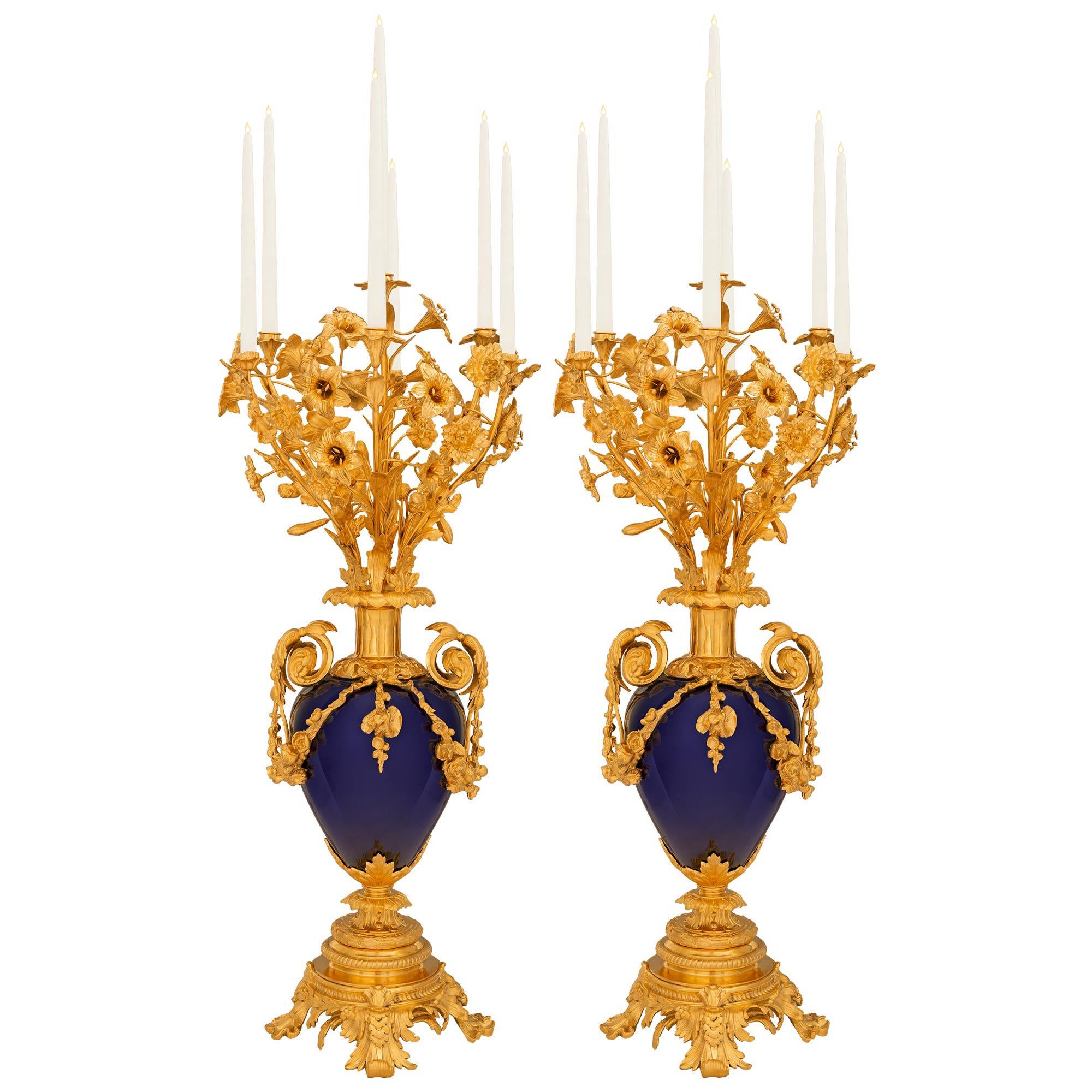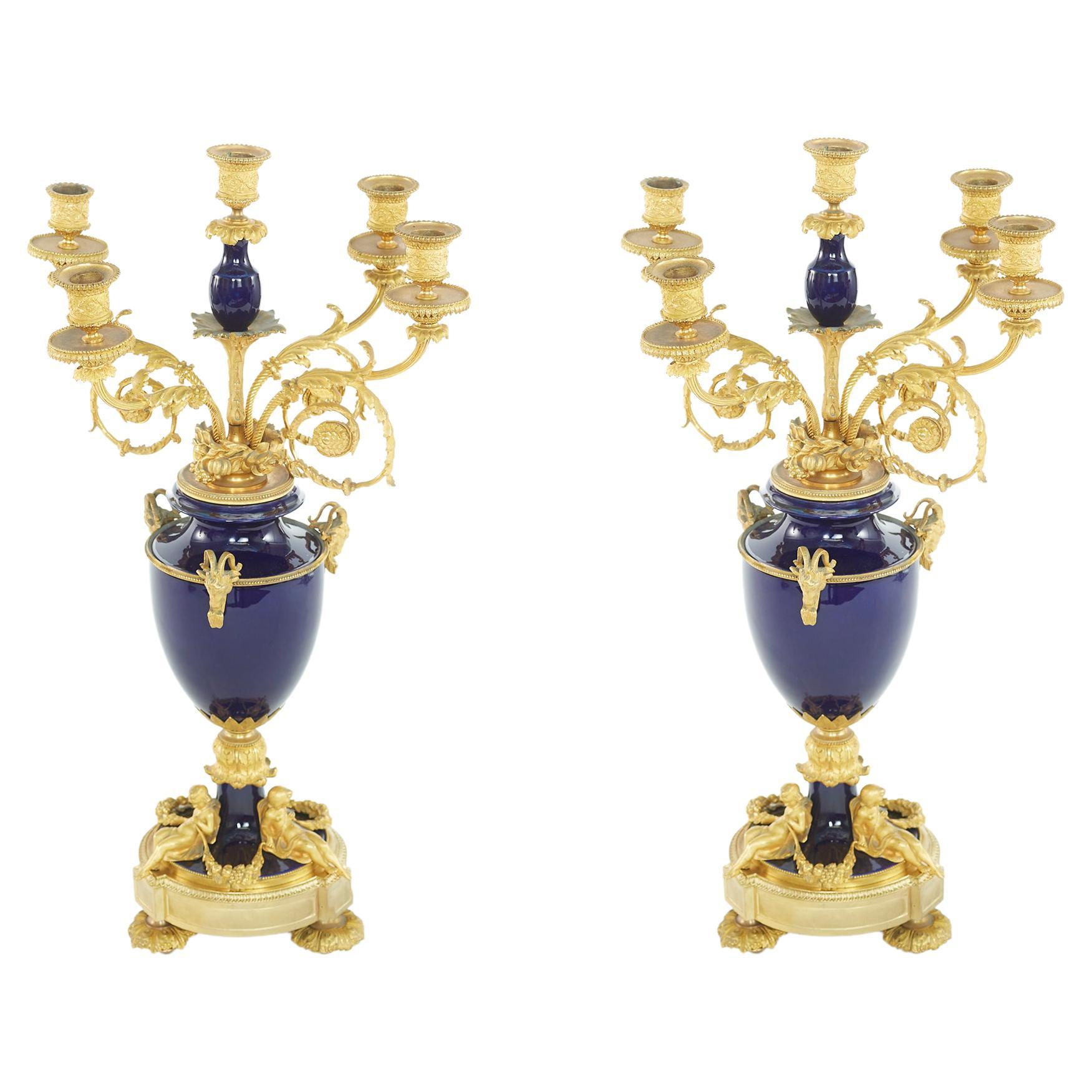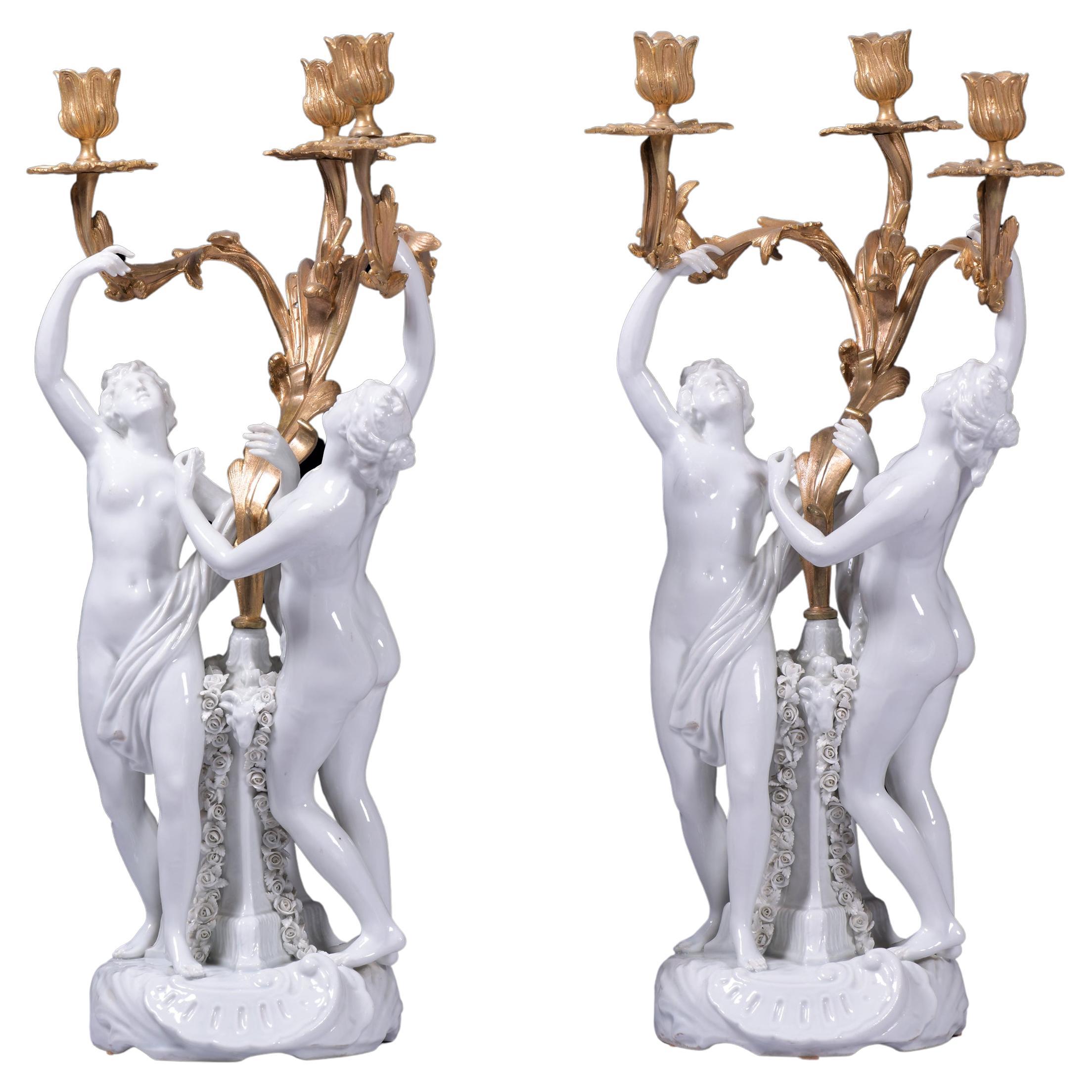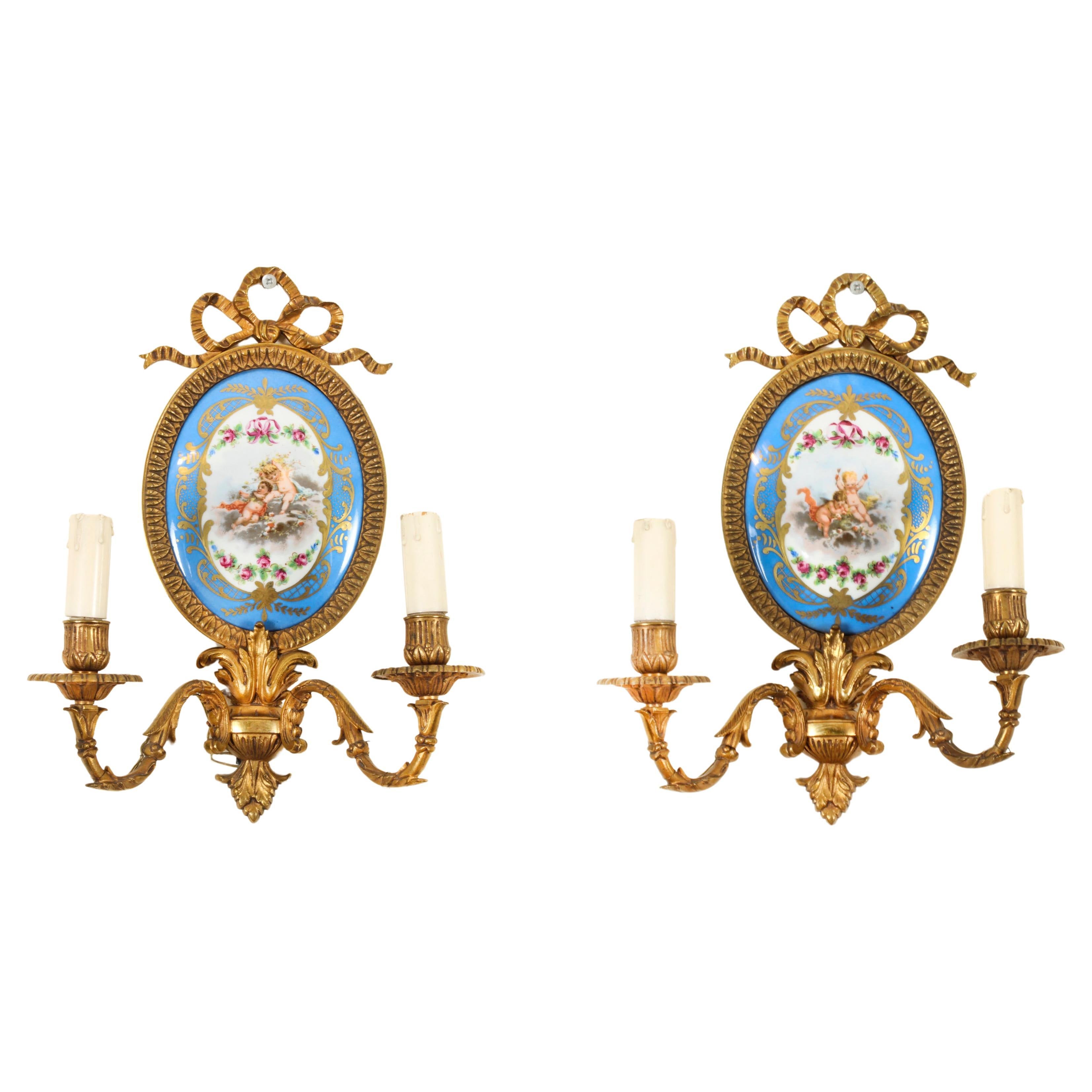Items Similar to Antique Pair Sevres Bleu Celeste Porcelain & Ormolu Candelabra 19th C
Video Loading
Want more images or videos?
Request additional images or videos from the seller
1 of 22
Antique Pair Sevres Bleu Celeste Porcelain & Ormolu Candelabra 19th C
About the Item
A pair of late 19th century French porcelain and ormolu mounted three light candelabra, each with floral and leaf branches above cherubic central column, to floral painted porcelain collar and on stepped circular base,
This is a delightful antique pair of Louis Revival ormolu and Sevres porcelain three-branch candelabra, circa 1860 in date.
Each candelabra features floral and leaf branches with detachable sconces above beautifully sculpted cherubic central columns with inverted baluster Bleu Céleste columns below. The bleu celeste bases have panels of hand painted country flowers with gilt highlights raised on stepped circular bases on tripartite feet.
There is no mistaking their unique quality and design which is sure to be cherished by any admirer of ornamental porcelain.
Condition:
In really excellent condition, please see photos for confirmation.
Dimensions in cm:
Height 44 x Width 17 x Depth 14
Dimensions in inches:
Height 1 foot, 5 inches x Width 7 inches x Depth 5 inches
Ormolu
(from French 'or moulu', signifying ground or pounded gold) is an 18th-century English term for applying finely ground, high-carat gold in a mercury amalgam to an object of bronze.The mercury is driven off in a kiln leaving behind a gold-coloured veneer known as 'gilt bronze'.
The manufacture of true ormolu employs a process known as mercury-gilding or fire-gilding, in which a solution of nitrate of mercury is applied to a piece of copper, brass, or bronze, followed by the application of an amalgam of gold and mercury. The item was then exposed to extreme heat until the mercury burned off and the gold remained, adhered to the metal object.
No true ormolu was produced in France after around 1830 because legislation had outlawed the use of mercury. Therefore, other techniques were used instead but nothing surpasses the original mercury-firing ormolu method for sheer beauty and richness of colour. Electroplating is the most common modern technique. Ormolu techniques are essentially the same as those used on silver, to produce silver-gilt (also known as vermeil).
Sevres Porcelain
traces its roots in France to early craftsmen who had small manufacturing operations in such places as Lille, Rouen. St. Cloud, and most notably Chantilly. It is from Chantilly that a cadre of workers migrated to the Chateau de Vincennes near Paris to form a larger porcelain manufactory in 1738.
French King Louis XV, perhaps inspired by his rumoured relationship with mistress Madame de Pompadour, took an intense interest in porcelain and moved the operation in 1756 to even larger quarters in the Paris suburb of Sevres. Sevres was also conveniently near the home of Madame de Pompadour and the King's own Palace at Versailles.
From the outset the king's clear aim was to produce Sevres Porcelain that surpassed the established Saxony works of Meissen and Dresden. Though the French lacked an ample supply of kaolin, a required ingredient for hard-paste porcelain (pate dure), their soft-paste porcelain (pate tendre) was fired at a lower temperature and was thus compatible with a wider variety of colours and glazes that in many cases were also richer and more vivid. Unglazed white Sevres Porcelain "biscuit" figurines were also a great success. However, soft-paste Sevres Porcelain was more easily broken. Therefore, early pieces of Sevres Porcelain that remain intact have become rare indeed.
The Sevres Porcelain manufactory always seemed to be in dire financial straits despite the incredibly fine works it produced. In fact, the king's insistence that only the finest items be created may have contributed to the difficulties. Only a limited number of European nobility could afford the extravagant prices demanded for such works. King Louis XV and eventually his heir, the ill-fated Louis XVI, were obliged to invest heavily in the enterprise. Ultimately, the Sevres Porcelain Factory produced items under the name of "Royal" and thus the well-known Sevres mark was born. King Louis XV even mandated laws that severely restricted other porcelain production in France so as to retain a near monopoly for his Sevres Porcelain. The king even willingly became chief salesman for the finest of his products, hosting an annual New Year's Day showing for French nobility in his private quarters at Versailles. He eagerly circulated among potential buyers, pitching the merits of ownership and policing the occasional light-fingered guest.
Sevres Porcelain may have indeed given the makers of Meissen and Dresden a run for their money by the end of the 18th Century but for the French Revolution. By 1800, the Sevres Porcelain Works were practically out of business due to the economic devastation of the new French Republic.
About the time when Napoleon Bonaparte named himself Emperor of France (1804), a new director was named for the Sevres Porcelain Manufactory. Alexandre Brongniart, highly educated in many fields, resurrected Sevres Porcelain. Soft-paste porcelain was eliminated altogether thanks to the earlier discovery of kaolin near Limoges. For four decades until his death, Brongniart presided over monumental progress for Sevres Porcelain, catering not only to Napoleon himself, but at last to include the more financially profitable mid-priced market in the emerging middle class.
- Dimensions:Height: 17.33 in (44 cm)Width: 6.7 in (17 cm)Depth: 5.52 in (14 cm)
- Sold As:Set of 2
- Materials and Techniques:
- Place of Origin:
- Period:
- Date of Manufacture:circa 1860
- Condition:
- Seller Location:London, GB
- Reference Number:
About the Seller
5.0
Platinum Seller
These expertly vetted sellers are 1stDibs' most experienced sellers and are rated highest by our customers.
Established in 1983
1stDibs seller since 2012
1,198 sales on 1stDibs
Typical response time: 1 hour
Associations
LAPADA - The Association of Arts & Antiques Dealers
- ShippingRetrieving quote...Ships From: London, United Kingdom
- Return PolicyA return for this item may be initiated within 14 days of delivery.
More From This SellerView All
- Antique Bleu Celeste Sevres Porcelain Ormolu Table Lamp 19th CenturyLocated in London, GBThis is a stunning large antique French Sevres hand-painted porcelain and ormolu mounted vase circa 1870 in date, later converted into a lamp. The ovoid porcelain body is painted...Category
Antique 1870s French Table Lamps
MaterialsOnyx, Ormolu
- Antique Pair Ormolu & Sevres Porcelain Two Branch Wall Lights Sconces 19th CLocated in London, GBThis is a stunning Antique pair of Sevres porcelain and ormolu wall lights, Circa 1870 in date. They feature hand painted oval plaques depicting cherubs in clouds surrounded by flo...Category
Antique 1870s Candlesticks
MaterialsOrmolu
- Antique Pair French Bleu Celeste Sevres Urns 19th CLocated in London, GBThis is a beautiful antique pair of French Sevres style porcelain and ormolu mounted twin handled urns, in the Louis XV manner, Circa 1870 in date. The bleu celeste...Category
Antique 1870s French Urns
MaterialsOrmolu
- Antique Pair of French Ormolu Mounted Bleu Celeste Sèvres Vases, 19th CenturyLocated in London, GBThis is a beautiful antique pair of French Louis Revival Sèvres "Bleu Celeste" porcelain and ormolu mounted twin handled vases, circa 1880 in date. They are superbly decorated in ...Category
Antique 1880s French Vases
MaterialsOrmolu
- Antique Bleu Royale Sèvres Porcelain Ormolu Table Lamp, 19th CenturyLocated in London, GBThis is a stunning large antique French Sèvres "Bleu Royale" hand painted porcelain and ormolu-mounted vase circa 1870 in date, later converted into a lamp. The ovoid porcelain bo...Category
Antique 1870s French Porcelain
MaterialsOrmolu
- Antique Pair of French Bleu Celeste Sèvres Vases Lamps, 19th CenturyLocated in London, GBThis is an exquisite large pair of French Sèvres Porcelain and ormolu mounted oil burning table lamps that have been skillfully converted to electricity ...Category
Antique 1870s French Porcelain
MaterialsOrmolu
You May Also Like
- Pair Sèvres Porcelain Ormolu Gilt Bronze Celeste Blue Candelabra CandlesticksBy Manufacture Nationale de SèvresLocated in Dublin, IrelandA fine stylish and imposing pair of French three light table or mantle Sevres porcelain mounted ormolu candelabra of outstanding quality. Early to mid-nineteenth century. Each with...Category
Antique 19th Century French Late Victorian Candelabras
MaterialsOrmolu, Bronze
- Pair Of French 19th Century Louis XVI St. Sèvres Porcelain & Ormolu CandelabrasBy Manufacture Nationale de SèvresLocated in West Palm Beach, FLAn impressive and large scale pair of French 19th century Louis XVI st. Sèvres Porcelain and Ormolu candelabras. The richly decorated pair of seven arm candelabras are supported by f...Category
Antique 19th Century French Louis XVI Candelabras
MaterialsOrmolu
- 19th Century Bronze Ormolu / Porcelain Pair CandelabraLocated in Tarry Town, NY19th century bronze ormolu mounted framed with porcelain pair of five light candelabra. Each piece featuring an urn shape with five light candelabras with a cobalt background and gil...Category
Antique 1860s French Candelabras
MaterialsBronze
- 19th Century Pair Of Capodimonte Porcelain & Ormolu CandelabraBy CapodimonteLocated in Dublin, IEA fine pair of 19th century Neo-classical Style porcelain and ormolu candelabra by Capodimonte. Circa 1860 Origin: Italy Capodimonte porcelain is porcelain created by the Capodimo...Category
Antique 19th Century Italian Neoclassical Revival Candelabras
MaterialsPorcelain
- Antique Pair French Ormolu Gilt Bronze Sevres Porcelain Candelabras CandlesticksBy Manufacture Nationale de SèvresLocated in Dublin, IrelandA Fine Stylish and Imposing Pair of French Three Light Table or Mantle Sevres Porcelain Ormolu Mounted Candelabra of outstanding quality. Mid to late Nineteenth Century. Each with ...Category
Antique 19th Century French Late Victorian Candelabras
MaterialsOrmolu
- Large Pair of 19th Century French Sevres Style and Ormolu CandelabraBy Manufacture Nationale de SèvresLocated in Brighton, SussexA very good quality pair of 19th century French Sevres style porcelain and gilded ormolu candelabra, each having five scrolling foliate branch sconces coming off the turquoise ground...Category
Antique Late 19th Century French Candelabras
MaterialsOrmolu
Recently Viewed
View AllMore Ways To Browse
Candelabra Sconces
Candelabra Sconce
Sconce Candelabra
Pair Sconces Candelabra
Antique Furniture Buyers
Leaf Branch
Brass Sconce Candelabra
Brass Candelabra Sconce
19th Ormolu Porcelain
Porcelain And Ormolu Mounted
Small Candelabra
Veneerer Ormolu Gilt Furniture
Pair Sevres
Antique Candelabra Brass
Antique Brass Candelabras
Antique Brass Candelabra
Brass Antique Candelabra
Brass Candelabras Antique





